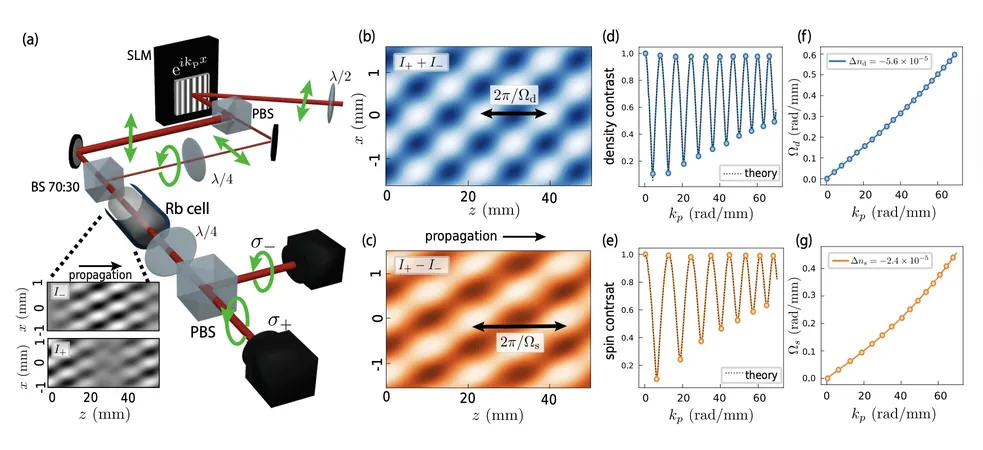
Groundbreaking Discovery: Scientists Unleash the Secrets of Light Flowing Like a Superfluid!
2025-07-09
Author: Jia
In an astonishing development in the field of physics, researchers have unveiled that light can behave in ways previously thought impossible—flowing like a "superfluid." This phenomenon echoes the astonishing characteristics of superfluids such as ultracold atomic gases and helium-4, known for their remarkable ability to flow without any resistance.
Revolutionary Research at Sorbonne University
At the prestigious Laboratoire Kastler Brossel at Sorbonne Université-CNRS, a team of researchers has published a groundbreaking paper in Physical Review Letters. They have demonstrated that photons in a two-component fluid of light can exhibit intricate behaviors, showcasing both spin and density modes—signatures of complex quantum superfluid mixtures. This discovery could pave the way towards revolutionary simulations and explorations of quantum many-body physics using optical systems.
What Is a Quantum Fluid of Light?
"We explore quantum fluids of light, which are optical systems where light exhibits superfluid-like properties, akin to Bose-Einstein condensates and superconductors," explains Quentin Glorieux, the senior author of the study. The goal? To push the boundaries of this analogy by creating a mixture of two interacting light fluids. These mixtures are fascinating because they enable rich collective dynamics and introduce a new arena for investigating quantum phase transitions, topological structures, and even analog gravity.
Collective Oscillations: The Key to Observation
To classify a system as a two-component quantum fluid, it must demonstrate two types of collective oscillations. The first is a total density oscillation of photons (density mode), while the second involves differences between the two fluid components (spin mode).
Inside the Experiment: The Mechanics of Light Interaction
Clara Piekarski, the lead author, elaborates on the experiment: "In our study, the quantum fluid wavefunction equates to the electric field envelope of a laser beam traveling through a hot atomic vapor of rubidium. Here, photons started to interact effectively. The two components represent the different circular polarizations of light, behaving like distinct particle species in this exotic mixture."
The Marvel of Superfluidity
The researchers cleverly split a laser beam into two, each with unique circular polarization, and guided them through rubidium vapor. Once inside, the light began to mimic a superfluid, flowing freely without any resistance. By perturbing the fluid-like optical system with a carefully controlled light beam, they observed two different types of excitations propagating without dissipation.
A Major Breakthrough: First Binary Superfluid of Photons!
"Our most significant achievement is the unmistakable observation of both spin and density modes within this two-component fluid of light," Glorieux reveals. "We successfully excited these modes selectively and measured two different speeds of sound, one associated with each mode. This marks the first experimental realization of a binary superfluid constructed from photons, greatly expanding the realm of quantum fluids of light!"
Unprecedented Control Over Light Dynamics
Not only did the scientists observe the spin and density modes, but they also discovered that they could manipulate the relative speeds of these modes by adjusting the photon density. This unique tunability, facilitated by the saturation of the atomic vapor, is an exclusive feature of light fluids—something unattainable in other known superfluids.
What’s Next? Exploring Quantum Instabilities!
"Our findings open doors to an array of exciting possibilities," adds Piekarski.
"We are now able to explore scenarios where only the spin or the density exhibits superfluid properties. Currently, we are investigating the non-miscible regime, where the spin mode becomes unstable, prompting the two components to occupy distinct spatial regions. This could lead to fascinating studies of quantum hydrodynamical instabilities by inducing collisions between the two components."



 Brasil (PT)
Brasil (PT)
 Canada (EN)
Canada (EN)
 Chile (ES)
Chile (ES)
 Česko (CS)
Česko (CS)
 대한민국 (KO)
대한민국 (KO)
 España (ES)
España (ES)
 France (FR)
France (FR)
 Hong Kong (EN)
Hong Kong (EN)
 Italia (IT)
Italia (IT)
 日本 (JA)
日本 (JA)
 Magyarország (HU)
Magyarország (HU)
 Norge (NO)
Norge (NO)
 Polska (PL)
Polska (PL)
 Schweiz (DE)
Schweiz (DE)
 Singapore (EN)
Singapore (EN)
 Sverige (SV)
Sverige (SV)
 Suomi (FI)
Suomi (FI)
 Türkiye (TR)
Türkiye (TR)
 الإمارات العربية المتحدة (AR)
الإمارات العربية المتحدة (AR)